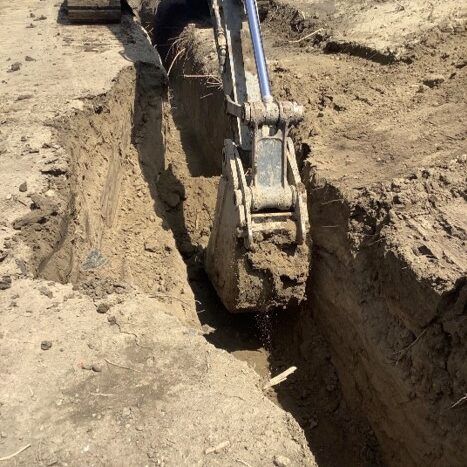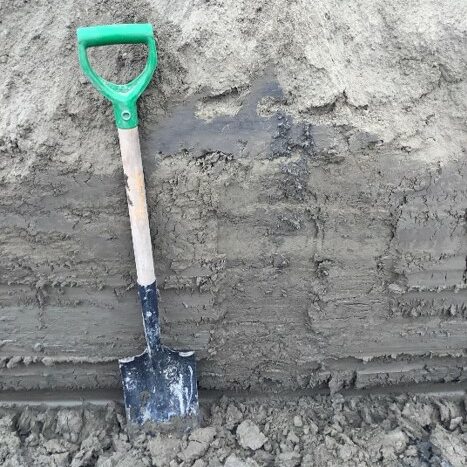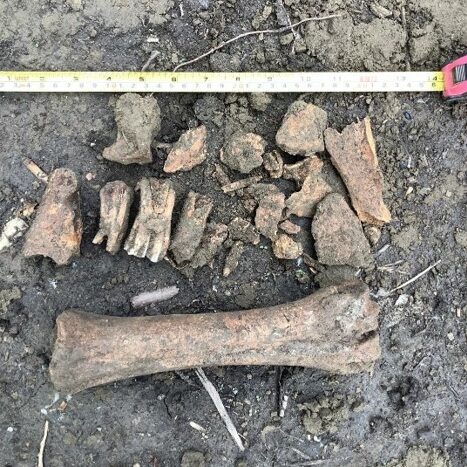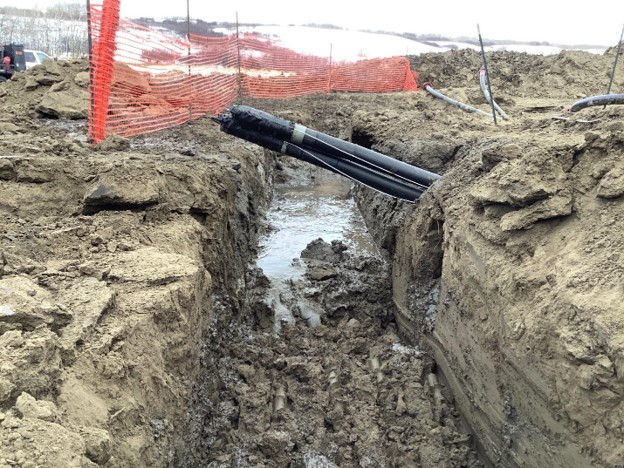A Closer Look at Monitoring for Archaeology at New Developments in Alberta
Written by: Alexandra Burchill
Archaeological monitoring consists of usually one to two archaeologists watching for archaeological material and searching backdirt piles on active construction sites. Monitoring is typically conducted during the winter months for a number of different projects, most common of which include a variety of oil and gas developments, buried utilities, and city infrastructure. Sounds fun, doesn’t it!? Probably the best part about monitoring is getting to see how construction happens for a wide variety of projects. Archaeological work is typically conducted in Alberta as pre-impact assessments, meaning that archaeologists are some of the first to go in and assess land prior to development occurring. We often miss out on watching the development in progress.

Monitoring work is not the first choice of archaeological assessment because often it is very destructive and easy to miss small finds such as flakes or bone shards (especially in frozen conditions). So why does the government allow developers to complete their Historic Resources Act requirements based on the results of archaeological monitoring? Sometimes traditional means of archaeological assessment, i.e. shovel testing and pedestrian reconnaissance, are not enough to locate potential archaeological sites in certain areas, especially in winter conditions with frozen ground. For example, a project that might require archaeological monitoring is a buried utility line repair in an urban environment where a backhoe operator and hydrovac personnel are required to delicately expose and fix the broken line. Pavement and metres of fill severely restricts the ability to shovel test. In addition, there may be intact buried soils identified around the fill from when the original line was placed. Preserved buried soils (aka paleosols) are exceptionally important to look out for when conducting any archaeological work. They indicate an old living surface where people may have once lived. If a paleosol is identified, the backdirt pile needs to be investigated more thoroughly for cultural material.
On most monitoring projects, the archaeologist will be working most closely with the operator, communicating when to stop digging and how many centimeters to be taken off with each scoop. Typically, the days include arriving at site for when the digging is about to commence and staying until it is completed for the day, mostly working 12-hour days. As it usually involves a lot of standing and watching, winter monitoring often requires extra gear to keep warm, thick gloves, and extra socks. Good thing we all got these Aurora Heat thumb warmers as a Christmas gift in 2019! We have extra; send us a DM if you want some 😉
Good note taking is a must, and after a while the notes may seem redundant if you are not finding anything, but the more detail the better. A typical entry will include the date, time of day, what the crew is expected to work on, the weather, anything of note, sediment descriptions, and photos, photos, photos!

When you find something, STOP the operator! Even if it is in the back dirt. Knowing where each scoop came from while the operator is digging is important because it will allow you to determine where in the trench/pit the material is from and where to look for further material. The material, whether it be faunal or lithic, needs to be photographed with a scale bar and the sediments from which it originated described. Any faunal remains will also need to be determined if they are cultural or natural. Cultural indicators on faunal remains include cut marks, intentional bone breakage, and burning.

In Alberta, any finds are communicated immediately to the Regional Archaeologist at the Archaeological Survey of Alberta and until permission to proceed is granted, construction is halted. If the finds are natural, construction can proceed, but if they are cultural, more archaeological work needs to be done to determine the site type, extent and ultimately the Historic Resource Value (HRV) of the site (more on that in a future blog). After the required monitoring is completed, a final report is compiled and submitted to the client and government.
Safety is a huge component when monitoring for archaeology. You are often working around large crews with active machinery and moving trucks. We have ground disturbance training for a reason and that is because of dangers working around trenches or pits. We cannot enter unprotected trenches that are deeper than 1.2 metres (4 feet). Eye contact with the operator is a must and good communication is a life-saver, literally! One trick a crew member on site told me early on was if you can’t get the operator’s attention and can only approach from behind the machinery, throw a stick or clump of dirt past his window to get his attention. Situational awareness is crucial on active construction sites where you are often out of place and not on the usual crew.
 Another aspect of monitoring to mention is that if you are a female archaeologist working solo you can expect to be the only female on site and crews can number quite high. So, it is a little unnerving to say the least! In addition, people may try to push you around, make you feel like your work is valueless, and harass you. Generally, the best policy is to establish boundaries and stand up for yourself. You’re there to do a job that many people are unfamiliar with and, let’s face it, most of the time they think you’re looking for dinosaurs. Once you establish that yes, you do know what you’re doing and yes, it is important, you’ll have less issues. Most of the time however, the crews are awesome to work with and super curious about archaeology and what you are looking for. 😊
Another aspect of monitoring to mention is that if you are a female archaeologist working solo you can expect to be the only female on site and crews can number quite high. So, it is a little unnerving to say the least! In addition, people may try to push you around, make you feel like your work is valueless, and harass you. Generally, the best policy is to establish boundaries and stand up for yourself. You’re there to do a job that many people are unfamiliar with and, let’s face it, most of the time they think you’re looking for dinosaurs. Once you establish that yes, you do know what you’re doing and yes, it is important, you’ll have less issues. Most of the time however, the crews are awesome to work with and super curious about archaeology and what you are looking for. 😊


